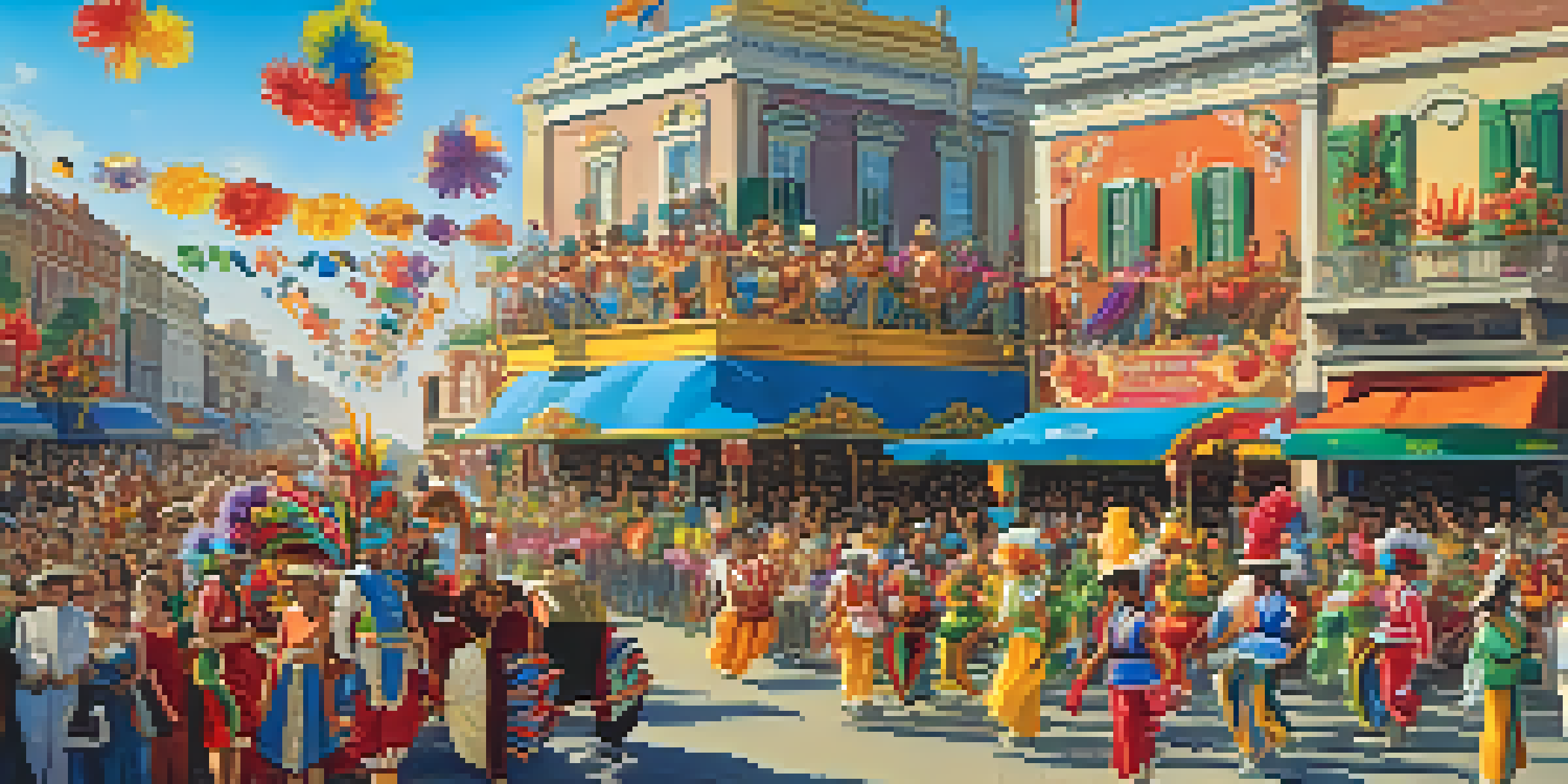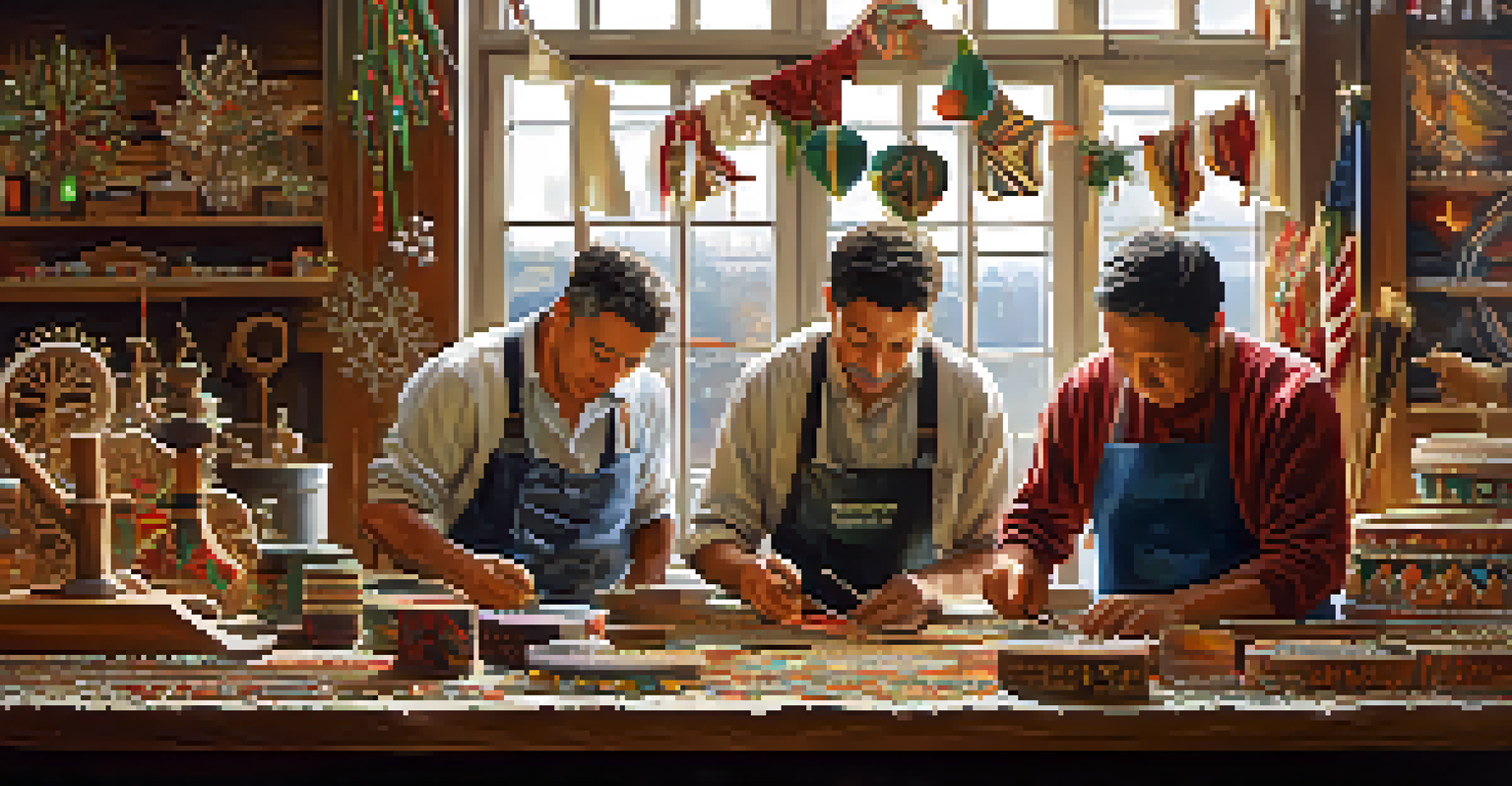The Art of Festive Decorations in Brazil's Cultural Celebrations

Understanding Brazil's Rich Cultural Tapestry
Brazil is a melting pot of cultures, where indigenous, African, and European influences blend beautifully. This diversity is vividly reflected in its festive decorations, which often tell stories of heritage and tradition. From Carnival to Junina festivals, each celebration showcases unique artistic expressions that resonate with the people.
Culture is the widening of the mind and of the spirit.
Take, for instance, the vibrant colors and patterns found in Carnival decorations, which symbolize joy and freedom. These decorations are not just visual spectacles; they are a form of storytelling that connects past and present. As you immerse yourself in these celebrations, you’ll notice how each element holds a piece of Brazil's complex history.
The artistry involved in these decorations often draws from local artisans who pour their heart and soul into their craft. This dedication adds layers of meaning to the festivities, inviting everyone to appreciate the cultural significance behind every colorful detail.
Carnival: The Heartbeat of Brazilian Festivities
Carnival is perhaps the most famous festival in Brazil, celebrated with unmatched enthusiasm and elaborate decorations. Streets come alive with parades, samba music, and floats adorned with flowers, feathers, and intricate designs. It’s a time when creativity knows no bounds, and the spirit of celebration fills the air.

The decorations during Carnival are not just for aesthetics; they embody themes of social issues, humor, and even political satire. Each float tells a story, often addressing relevant cultural narratives, making the event both entertaining and thought-provoking. This blend of art and commentary is a hallmark of Brazilian culture.
Brazil's Festivals Celebrate Diversity
Brazil's rich cultural tapestry is showcased through vibrant festivals like Carnival and Junina, highlighting the blend of indigenous, African, and European influences.
Moreover, the community involvement in crafting these decorations fosters a sense of unity and pride. Local groups collaborate to create stunning displays, showcasing their cultural identities and shared values. It’s a beautiful example of how art can bring people together in celebration.
Junina Festivals: A Celebration of Rural Heritage
Unlike the urban spectacle of Carnival, Junina festivals celebrate Brazil's rural roots, particularly during the winter months. These festivities are characterized by traditional decorations like colorful flags, straw hats, and bonfires, creating a warm and inviting atmosphere. The decorations represent the simple, rustic beauty of the countryside, transporting attendees to a different time and place.
Art is the most beautiful of all lies.
At Junina festivals, the decorations serve a dual purpose: they beautify the surroundings and evoke nostalgia for agrarian life. This connection to the past is vital, as it helps younger generations appreciate their heritage. The lively dances, traditional foods, and charming decor create an immersive experience that celebrates Brazil's agricultural roots.
The community aspect of Junina festivals is equally important. Families and friends come together to create decorations and participate in festivities, strengthening bonds and fostering a sense of belonging. This sense of community is essential in preserving these cultural traditions for future generations.
Artisan Craftsmanship Behind Festive Decorations
The stunning decorations seen during Brazil's festivals are often the result of skilled artisans who have honed their craft over generations. These artisans utilize local materials and techniques passed down through their families, ensuring that each piece is unique and rich in cultural significance. From hand-painted banners to meticulously crafted floats, their work is a testament to Brazil's artistic heritage.
Artisans take immense pride in their creations, often reflecting the stories and traditions of their communities. For example, the intricate beadwork found in Carnival costumes often depicts local legends and folklore. Each decoration becomes a narrative thread that weaves together the community's identity and history.
Artisan Craftsmanship Enriches Culture
Skilled artisans create unique decorations for festivals, reflecting community stories and preserving cultural heritage through their craftsmanship.
The dedication of these artisans not only enriches the festivals but also strengthens the cultural fabric of Brazil. By supporting local craftsmanship, festival-goers contribute to the preservation of these art forms, ensuring that they continue to thrive in the face of modernization.
Symbolism in Decorations: More Than Meets the Eye
In Brazilian festive decorations, every color, shape, and material carries meaning. For instance, the use of bright colors symbolizes joy and celebration, while specific patterns may represent cultural heritage or historical events. Understanding these symbols adds depth to the experience of participating in festivals, allowing attendees to connect on a more profound level.
Additionally, many decorations are steeped in religious or spiritual significance. For example, during certain festivals, you may see decorations that honor saints or celebrate particular beliefs. These elements serve as reminders of Brazil's rich spiritual landscape and the intertwining of faith and culture.
As you navigate through the vibrant decorations, you might find yourself reflecting on your own interpretations of these symbols. This personal connection enhances the festive experience, making it a shared journey of discovery among attendees.
Sustainability in Festive Decorations: A Growing Concern
In recent years, there has been a growing awareness of sustainability in the creation of festive decorations in Brazil. Many artisans and organizers are now prioritizing eco-friendly materials and practices to minimize environmental impact. This shift reflects a broader cultural movement towards sustainability, emphasizing the need to protect Brazil's rich natural resources.
For example, some festivals now feature decorations made from recycled materials or natural elements like leaves and flowers. This not only reduces waste but also encourages creativity in the crafting process. By embracing sustainable practices, festivals can continue to be vibrant and lively while respecting the environment.
Sustainability in Celebrations
A growing focus on eco-friendly practices in creating festive decorations illustrates Brazil's commitment to sustainability and the preservation of its natural resources.
Furthermore, this commitment to sustainability resonates with younger generations who are increasingly concerned about environmental issues. As they participate in festivals, they also become advocates for preserving cultural traditions in an eco-conscious manner, ensuring that the art of festive decorations can thrive for years to come.
The Future of Festive Decorations in Brazil
As Brazil continues to evolve, so too do its festive decorations. The influence of modern technology and globalization has introduced new materials and styles, blending traditional and contemporary designs. This evolution creates exciting opportunities for artistic expression and innovation within Brazilian culture.
However, while embracing modernity, it’s essential to maintain a connection to the roots of these traditions. Festivals must find a balance between honoring their heritage and exploring new creative avenues. This thoughtful approach ensures that the essence of Brazilian culture remains vibrant and relevant.

The future of festive decorations in Brazil lies in collaboration between artisans, communities, and festival organizers. By working together, they can create a rich tapestry of celebrations that honor the past while embracing the future, ensuring that the art of festive decorations continues to thrive in the heart of Brazilian culture.